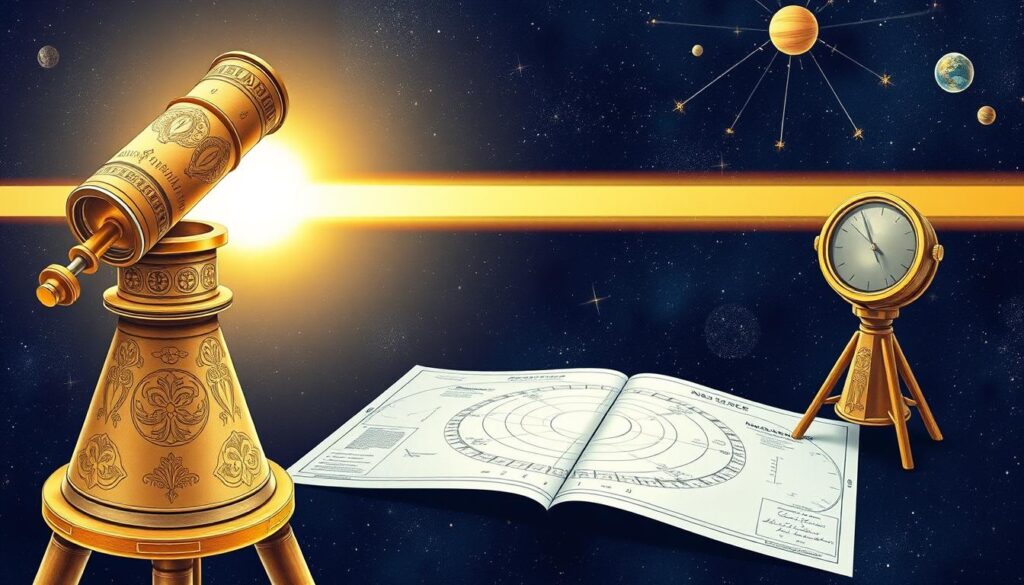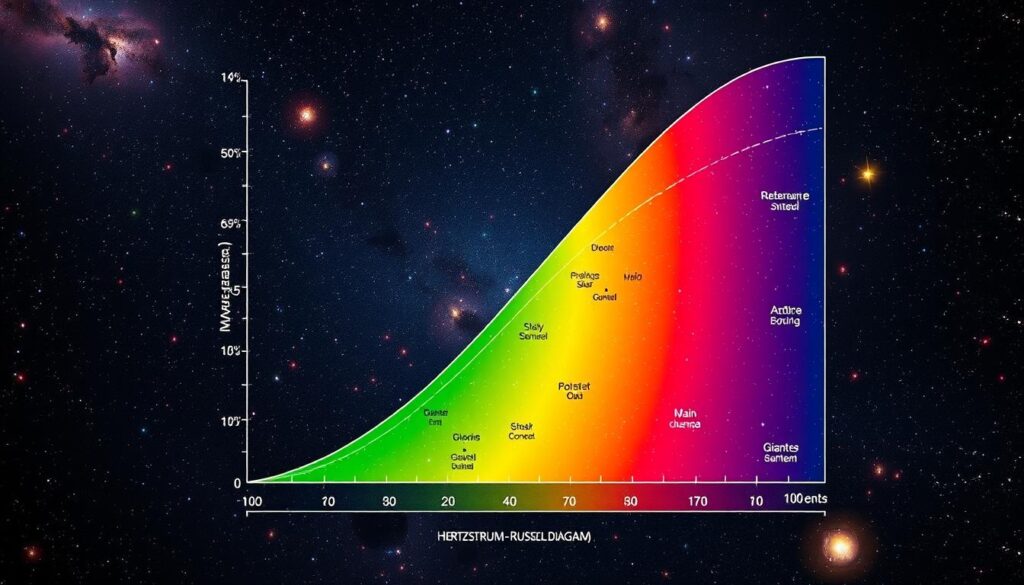
A vast night sky filled with a multitude of stars, each showcasing varying levels of brightness, with some stars radiating intensely while others twinkle faintly, surrounded by a deep blue-black cosmos and scattered wisps of glowing nebulae, creating a mesmerizing display of celestial beauty.
The night sky is filled with twinkling stars that capture our imagination. Ever wondered why some stars seem brighter than others? The answer is in the concept of apparent magnitude. It’s a key measure in astronomy that shows how bright stars and other objects appear from Earth.
Apparent magnitude is a scale that shows how bright something looks in the sky. Objects that shine brightly have a low number, while faint ones have a higher number. This scale helps astronomers and stargazers understand the differences in brightness. It gives us insights into the universe’s nature and makeup.
Key Takeaways
- Apparent magnitude is a measure of the apparent brightness of celestial objects as observed from Earth.
- Bright objects have a low apparent magnitude, while dim objects have a higher apparent magnitude.
- Apparent magnitude is a crucial tool for astronomers and stargazers to study and understand the night sky.
- By learning about apparent magnitude, you can gain deeper insights into the nature and composition of the universe.
- Apparent magnitude helps classify and categorize the varying brightness of stars, planets, and other celestial bodies.
What is Apparent Magnitude?
Apparent magnitude is a way to measure how bright things in the sky look from Earth. It shows how bright an object seems, not how bright it really is. The scale goes from negative numbers for the brightest to positive for the dimmest. A lower number means something is brighter.
Understanding the Concept
In astronomy, apparent magnitude is key. It lets astronomers compare how bright stars and other objects are. This scale is based on how our eyes see starlight. It gives a standard way to measure brightness.
Significance in Astronomy
- Apparent magnitude helps astronomers understand the brightness measurement of stars and other celestial objects.
- It allows for the categorization and comparison of celestial bodies based on their apparent brightness.
- Apparent magnitude data is crucial for various astronomical applications, such as star classification and the study of variable stars.
“Apparent magnitude is a fundamental concept in astronomy that allows us to quantify the brightness of celestial objects as seen from Earth.”
Factors Affecting Apparent Magnitude
The brightness we see from a star or planet is shaped by two main things. These are how far it is from us and how bright it naturally is.
Distance from the Observer
How close a star is to us greatly affects its brightness. Stars near us seem brighter, while distant ones appear fainter. This is because the distance to celestial objects affects how much light we get from them.
Intrinsic Brightness
The intrinsic brightness or luminosity of a star also matters. Brighter stars have a lower apparent magnitude, looking brighter to us. Less bright stars have a higher apparent magnitude, looking dimmer.
The mix of distance to celestial objects and intrinsic brightness decides a star’s apparent magnitude. Knowing these factors affecting apparent magnitude helps astronomers understand the universe better.
Apparent Magnitude Scale
The apparent magnitude scale is key in astronomy. It measures how bright stars and planets seem from Earth. It ranges from -1 to +6, with lower numbers meaning they are brighter.
Things like the Sun and Venus are very bright, with negative numbers. The faintest things we can see have a +6. This scale helps astronomers compare the brightness of different objects in space.
| Apparent Magnitude Range | Brightness Description |
|---|---|
| -1 to 0 | Exceptionally Bright |
| 0 to +3 | Bright |
| +3 to +6 | Visible to the Naked Eye |
| +6 to +9 | Faint |
| +9 and above | Extremely Faint |
The apparent magnitude scale is crucial in astronomy. It gives a standard way to measure how bright things appear from Earth.
“The apparent magnitude scale is a powerful tool that allows us to precisely measure and understand the luminosity of stars and other celestial bodies, revealing the intricate tapestry of our universe.”
Measuring Apparent Magnitude

A beautifully detailed illustration of various astronomical instruments used for measuring star brightness, including a vintage telescope with intricate engravings, a modern photometer, and a bright star chart spread out against a dark starry sky, with celestial bodies twinkling in the background.
Astronomers use many ways and tools to measure how bright stars and planets seem to us. This is called photometry. It turns the light from these objects into a number on a scale.
Observational Techniques
To measure brightness, astronomers watch how bright an object is and compare it to known standards. They use methods like looking with the eye, using special tools, and taking pictures with cameras.
- Visual estimation: Skilled observers compare an object’s brightness to nearby stars.
- Aperture photometry: A tool called a photometer measures the light through a set area.
- Digital imaging: Cameras and CCD detectors take detailed pictures, helping to figure out brightness.
Instruments and Tools
Astronomers have many tools to help measure brightness. They use big telescopes, special photometers, and advanced cameras.
| Instrument | Purpose |
|---|---|
| Telescopes | Collect and focus light from distant objects, helping with accurate measurements. |
| Photometers | Measure light intensity, turning it into a number on the brightness scale. |
| Digital Cameras | Take detailed pictures, allowing for brightness calculations. |
With these methods and tools, astronomers can accurately measure the brightness of stars, planets, and more. This helps us understand the universe better.
Applications of Apparent Magnitude
Apparent magnitude is key in astronomy, helping both experts and hobbyists. It lets us see how bright stars and planets are. This helps us explore the universe’s secrets.
It’s mainly used to sort and compare stars, planets, and other bright things. Astronomers use it to learn about these objects’ true nature and how they change over time. For example, it helps find variable stars. These stars change brightness, giving us clues about their inside and how they act.
Also, apparent magnitude helps figure out how far away stars and other objects are. By knowing how bright they look, astronomers can guess their true light and where they are in space. This helps us understand how galaxies form and grow.
In stargazing, apparent magnitude is a key tool. It helps us see how bright stars and other sky objects are. This lets us plan our stargazing, so we can see the most amazing sights in the sky.
Apparent magnitude has many uses in astronomy applications. It helps classify objects and explore the universe’s structure and growth. This important idea is vital for both professional astronomers and hobbyists.
Apparent Magnitude and Star Classification

A vibrant and detailed Hertzsprung-Russell diagram showcasing the relationship between star brightness and temperature, featuring a gradient of colors representing various star types, including main sequence stars, giants, and white dwarfs, set against a cosmic background filled with stars and nebulae, illustrating the diversity of stellar classification.
The concept of apparent magnitude is closely linked to the classification of stars. The Hertzsprung-Russell diagram plots stars by their absolute magnitude and spectral type. These are related to their innate luminosity and surface temperature. By understanding the relationship between apparent magnitude and the inherent properties of stars, astronomers can gain valuable insights into the nature and evolution of these celestial objects.
Stellar Brightness Classes
Stars are categorized into different brightness classes based on their apparent magnitude. This reflects their observed luminosity from Earth. These classes include:
- Supergiants – Extremely bright stars with low apparent magnitudes, typically less than 0.
- Giants – Bright stars with apparent magnitudes between 0 and 2.
- Main Sequence – The most numerous class of stars, with apparent magnitudes typically between 2 and 6.
- Subdwarfs – Relatively dim stars with apparent magnitudes greater than 6.
By analyzing the apparent magnitude and other observable characteristics of stars, astronomers can determine their position on the Hertzsprung-Russell diagram. This helps them understand their stellar brightness, surface temperature, and overall star classification.
“The Hertzsprung-Russell diagram is a powerful tool for understanding the nature and evolution of stars, with apparent magnitude being a crucial factor in this analysis.”
Challenges and Limitations
Apparent magnitude is a key tool in astronomy, but it faces many challenges. Several factors can mess with the accuracy of these measurements. Astronomers must think carefully about these when studying the sky.
The Earth’s atmosphere can change how bright objects seem. Air turbulence, dust, and moisture can block light. Light pollution from cities also makes it hard to see how bright stars are.
The logarithmic scale used for apparent magnitude can be tricky. It’s hard to tell how bright objects are when they’re only slightly different. Astronomers need to be careful when using this scale.
Dust and gas in space can also change how bright objects seem. This is called interstellar extinction. It makes measuring apparent magnitude even harder.
Despite these issues, astronomers have found ways to get better measurements. They use special techniques and tools. This helps them understand the universe better.
In summary, apparent magnitude is crucial in astronomy, but it’s not easy to measure. Astronomers face many challenges. By working on these, they can make their observations more accurate. This helps us learn more about the universe.
Conclusion
The idea of apparent magnitude is key in astronomy. It helps us understand how far away and bright stars and galaxies are. This knowledge lets astronomers measure and sort the many objects in our sky.
This tool is used in many ways. It helps figure out how far away things are and how stars change over time. It’s a big help in studying the universe.
As we get better at looking at the sky, apparent magnitude will become even more important. It lets us learn more about the summary of apparent magnitude and its importance in astronomy. Exploring the universe is always exciting and full of new things to find.
Studying apparent magnitude shows how powerful science can be. By measuring how bright things are, astronomers have learned a lot about our universe. This knowledge will lead to even more amazing discoveries in the future.
Important Point
NO. | Important Points |
1. | |
2. | |
3. | |
4. |
FAQs of Apparent Magnitude
What is apparent magnitude?
Apparent magnitude is a way to measure how bright stars and other objects seem from Earth. It shows how bright they look in the sky, not how bright they really are.
How does distance affect apparent magnitude?
The closer an object is to us, the brighter it seems. Objects far away seem dimmer. This is because of how far they are from us.
What is the apparent magnitude scale?
The scale ranges from -1 to +6 for things we can see with our eyes. Lower numbers mean objects are brighter. Higher numbers mean they are dimmer. Very bright objects, like the Sun, have negative numbers.
How do astronomers measure apparent magnitude?
Astronomers use tools like telescopes and cameras to measure light from objects. They turn this light into a number on the apparent magnitude scale. This is called photometry.
What are the applications of apparent magnitude?
It helps astronomers classify and compare the brightness of stars and planets. It’s also used to find variable stars and figure out how far away things are.
How is apparent magnitude related to star classification?
It’s key in classifying stars by their brightness. The Hertzsprung-Russell diagram uses it to show stars’ brightness and temperature. This helps us understand stars better.
What are some challenges and limitations of using apparent magnitude?
Things like weather, light pollution, and dust can make it hard to measure brightness accurately. The scale can also be tricky to understand at times.
See these too
- Read Also: Exploring Asteroids: Cosmic Rocks in Our Solar System
- Read Also: What are the biomes of Earth?
